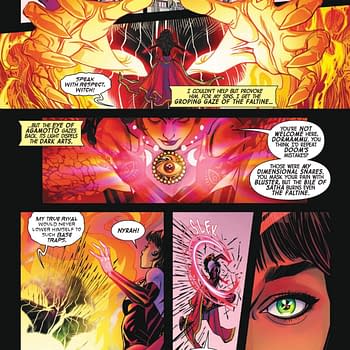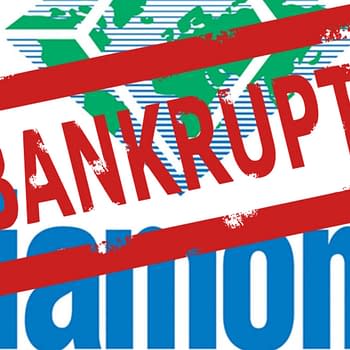Posted in: Comics, san diego comic con | Tagged: Comics, Corrina Bechko, entertainment, gabriel hardman, image, jonathan hickman, nick dragotta, sdcc
SDCC '15: Image Comics – Where Creators Own Process With Nick Dragotta, Jonathan Hickman, Corinna Bechko, Gabriel Hardman

"They're very different. Even if you have a similar idea to someone else, it's the execution that sets it apart."
Hardman spoke about the genesis of Invisible Republic, saying a kernel of an idea came from a centuries-old folk ballad.
Dragotta explained how they came up with their genre mash-up, as Hickman entered the panel minutes late. Hickman said he wanted a western story, while Dragotta wanted sci-fi. So, they combined them.
"We know how each other work and more importantly what we like," Hickman said. He mentioned that each direction changes, sometimes they talk it through and sometimes it's just a paragraph. "It's like jazz, at this point," he joked.
Hardman and Bechko, who are married, co-write the book in their home, and Hardman does the art in his studio. Both teams mentioned their scripts were tighter at first, and Brothers pointed out this common experience.
Hickman said a lot of his work is deadline-driven. "The market dictates so much of your schedule."
"The last two weeks of a deadline I don't see my wife or kids, I'm locked in my room working on pages I should have started two weeks ago," Dragotta said.
They began showcasing Dragotta's work on East of West, showing a thumbnail page juxtaposed with finished and colored pages. His work is all digital, which is sent to Frank Martin to color.
Hickman doesn't get too involved in the process. "Nick and Frank make it easy." Dragotta might send him work-in-progress, but Hickman prefers to see the final product so he can finish it on his end.
They discussed a recent issue of East of West, where a young boy named Babylon is learning to kill. Dragotta and Hickman had to work those beats out, and Dragotta mentioned that he decided to tone down his normally graphic violence for the scenes.
Brothers now brought up process pages for Hardman's Invisible Republic artwork. Hardman works on paper, citing his love of the tactile experience. He doesn't do all of his pencils before moving on to inks, he does it all as he goes. Hardman said maintaining creative momentum is key to his process.
"The art is not different from the writing. Both of them are storytelling," Hardman said. "The style of the art is really comparable to the style of the dialogue."
"A lot of people don't understand that they have to plan where the words have to go," Brothers mentioned, referring to placement of word balloons and caption boxes.
Hardman said he likes to express emotions as subtle as possible. "I want it to be quiet and then loud… It's not about pretty pictures, it's about telling the story."
Dragotta mentioned the freedom of not having a limited page count. He mentioned a scene where two characters meet and fight for the first time in the series. Dragotta said in other books, he would have shortened the build-up to a couple of panels. But he wanted to build the tension and dedicated a whole page to ramping up the intensity of their clash.
They discussed color pallets and working with color artists, and Hardman said he discussed specific influences with colorist Jordan Boyd but that he trusts him enough from prior collaborations to work it out.
Hickman praised Martin, calling him a true artist, and Dragotta said that he can leave certain smaller details out of his work. "I can draw just the shape and contour, and I know Frank is going to fill that in."
Brothers mentioned the timeline shifts in Invisible Republic and how certain panel layouts will change based on which time is shown. Hardman said that it felt like a natural device to make that distinction.
They mentioned caption boxes and how restricting they can be, especially when storytellers are showing a scene in the art and then describing the same scene in a caption box. "It forces you to tell the story differently," Bechko said.
Dragotta said his work is heavily influenced by manga, which he said is great at visual storytelling. "The writing is in the background," he said. He mentioned that he tries to give everything Hickman could need in the artwork, like he's challenging him as a writer. "But he comes in and writes something that adds this whole other layer."
Hickman said that he gets ideas from everything he reads and watches, so he has to curb his influences when he's working. "I've become a person who is really careful about what I consume," referring to media.
"If you're working comics, take influences from other stuff and not just the medium you're in," Hardman advised.
Hickman said it's not in a creator's best interest to make new IP for Marvel, so you're tending the ones they have in place. "What makes Image so great… is it's clear everyone is playing. Some people are playing at the highest level, others are just trying new shit, and that's cool."
They all expressed joy for working with Image and the creative culture they're fostering.
Brothers ended the panel by pointing out an East of West cosplayer, the adult version of the Horseman War, who received a shiny new hardcover for her costume.










